The BBC spoke to officials from both sides of the talks to piece together how the Gaza deal was done.
How historic ceasefire deal was sealed with 10 minutes to spare
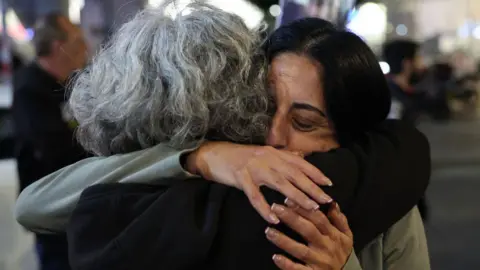 Getty Images
Getty ImagesThe Israeli and Hamas negotiators never came face to face – but by the end, just one floor separated them.
Ceasefire talks via middlemen from Qatar, Egypt and the US had been dragging on for several months, at times without hope. Now the key players were all inside one building in Doha and the pace was frantic.
A deal was close but things had gone wrong before: one source described a last-minute push to stop the agreement breaking down while a podium was being set up so the Qatari prime minister could announce it.
“Literally, negotiations were up until 10 minutes before the press conference. So that’s how things were stitched up at the last minute,” the source familiar with the talks said.
The BBC has spoken to a number of officials on all sides of the negotiations to piece together how the final fraught days of the secretive process unfolded.
Shifting ground
The deal did not come out of the blue.
The overall framework of the agreement reached on 15 January was broadly the same as the proposal set out by President Joe Biden during a White House address last May. It uses the same three-phase approach and will see a ceasefire, Israeli hostages released in return for Palestinian prisoners, and the Israeli military’s gradual withdrawal from Gaza.
But sources familiar with the discussions agreed the dynamics of the talks shifted decisively in mid-December and the pace changed.
Hamas, already reeling from Israel’s killing of its leader Yahya Sinwar in Gaza two months earlier, had become increasingly isolated. Its Lebanon-based ally Hezbollah had been decimated and had agreed to a truce with Israel. Bashar al-Assad’s Iran-backed government in Syria had also been swept away.
The view in Washington is that Hamas was forced to abandon the idea that “the cavalry was coming to save it”, as one US official put it.
“It is hard to overstate how fundamentally the equation changed and what that [did] for Hamas’s calculus,” says a senior Biden administration official familiar with the talks.
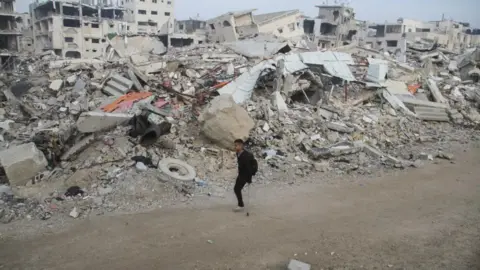 Reuters
ReutersAn Israeli official who wished to remain anonymous said Hamas was “not in a rush” to strike a deal and had been “dictating” rather than negotiating. They said that changed after the death of Sinwar and Israeli operations against Hamas’s allies in the region.
On top of that, the official said, there was “momentum created by both US administrations” – the Biden White House and the incoming Trump team.
“We could not achieve a deal like this until conditions had changed,” the official added.
On 12 December, Biden’s negotiating team visited Israeli Prime Minister Benjamin Netanyahu. White House national security adviser Jake Sullivan, Middle East envoy Brett McGurk and CIA director Bill Burns were all in attendance.
A US official, who spoke on the condition of anonymity, said the meeting lasted “multiple hours” and focused on the “new regional equation” and “how we catapult from the Lebanon ceasefire into another round of intensive discussions” on Gaza.
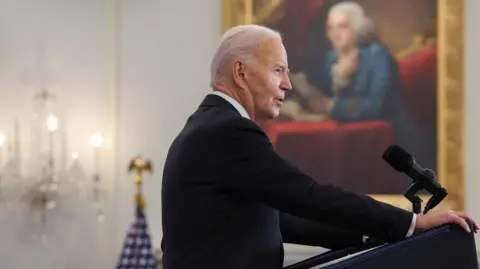 Reuters
ReutersThere was also another piece on the chessboard by this stage: Donald Trump.
On 16 December, weeks after Trump’s victory, the BBC spoke to a Hamas official who was unusually optimistic about the ceasefire efforts, suggesting they seemed to be more serious.
The official – who had taken part in every set of talks since November 2023 – appeared reassured by the fact that an adviser to the incoming US president had sent a message to mediators indicating Trump wanted an agreement before his inauguration.
Trump had also warned of “all hell to pay” if Hamas did not agree to release the hostages – but the Palestinian official was bullish.
“This time, the pressure will not be limited to Hamas, as was customary under the Biden administration,” the official said. “There will also be pressure on Netanyahu. He is the one obstructing the deal, and Trump seems to understand that very well.”
False dawns
However, that same official’s prediction that a deal could be done by Christmas proved to be optimistic.
During December, the process remained beset by problems. Israel publicly ruled out releasing certain high-profile prisoners, while the White House accused Hamas of throwing up roadblocks over the hostage releases.
A Biden administration official said: “Hamas [was] refusing to agree – and this was a breakdown at that point – to the list of hostages that would be released in phase one of the deal.
“That’s just so fundamental. This is a hostage release deal. Unless you agree to the list of hostages who will come out, there’s not going to be a deal.”
The same official said Hamas made “completely untrue” claims about not knowing the location of the hostages, and added: “We held the line and basically left the table until Hamas agreed to the hostage list.”
 EPA
EPAAn anonymous Israeli official said Hamas had sought to conceal the number of living hostages and “tried to dictate that they would send us only dead bodies”.
For its part, Hamas claimed Israel unexpectedly added 11 names to the list of hostages it wanted to be released in the first phase. Hamas considered them reserve soldiers, and therefore not eligible to be released alongside the women, injured and elderly hostages due to be released in phase one.
The door was left open to Qatari and Egyptian mediators to continue their efforts and on 3 January, there was an apparent breakthrough when Hamas proposed the release of 110 Palestinian prisoners serving life sentences in return.
There were by now well-established terms of reference for such trades. For each hostage Hamas was to release, Israel would have to provide what had become known in the nomenclature of the draft deal as a “key” – meaning an agreed number or even specific identities of Palestinian prisoners.
A US official said: “There’s an equation for how many Palestinian prisoners come out. So for female soldiers, for example, there’s a key. And for elderly males, there’s a key. And for women civilians, there’s a key. And this has all been worked out and the prisoners have been named, hundreds and hundreds of prisoners on the list.”
The exchange file in the negotiations – Palestinian prisoners for hostages held by Hamas – became known as “the keys”.
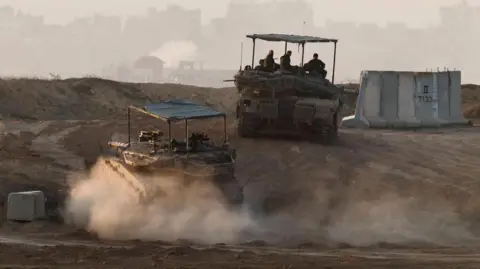 Reuters
ReutersDuring this phase of the talks, Hamas also relented on two long-standing demands: the complete withdrawal of Israeli forces from Gaza in the first phase and a formal Israeli commitment to a total ceasefire.
Sensing a breakthrough, the Egyptian mediator urgently dispatched Major General Ahmed Abdel Khaleq – who oversees the Palestinian portfolio in Egyptian intelligence – to Doha. After meeting with Hamas representatives, he secured confirmation the group would make what a senior Hamas official described as “painful concessions.”
But on 6 January, according to a Palestinian official, Israel rejected the offer put forward by Hamas on the 11 hostages. Hamas responded by sending the BBC and other media outlets a list featuring the names and ages of 34 Israeli hostages. Two days later, the body of one of those on that list – Yosef AlZayadni – was found inside Gaza.
The list included reserve soldiers, which indicated Hamas was willing to release them in the first phase.
This appeared to be an attempt to embarrass Netanyahu and rally hostage families in Israel and around the world to pressure him into accepting the deal.
It was also an indication Hamas had not walked away.
Metres apart
Meetings stretching into the small hours of Doha’s hot evenings became common during the final stretch of the negotiations.
In the last month, they had developed into so-called “proximity talks”, with both sides in the same two-storey building, according to multiple accounts from officials familiar with the details.
A senior US official said Hamas’s delegation was on the first floor and Israel’s on the floor above. Mediators ran pieces of paper between them. Maps of Israeli troop withdrawal proposals and details about hostages or prisoners drafted for release were shuttled back and forth.
“That takes an enormous amount of work and, I have to say, all of that was not fully nailed down, really, until just the [final] hours,” said the official.
Inside the building, the delegations met separately with senior figures from Qatar and Egypt. Among those closely involved in the details was Qatari Prime Minister Mohammed bin Abdulrahman Al Thani.
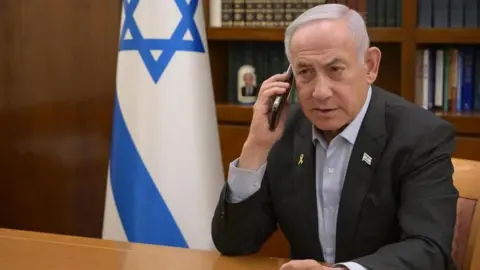 Reuters/Israeli Government Press Office
Reuters/Israeli Government Press OfficeTwo crucial areas were worked on in the final phases of the talks: the lists for release of hostages held by Hamas and Palestinian prisoners held by Israel, and the positions for Israeli troop withdrawals from populated areas in Gaza during phase one.
By 9 January, the pressure had escalated. Trump’s envoy, Biden’s envoy, and the Egyptian intelligence chief convened in Doha for a serious eight-hour negotiation session.
A senior Egyptian official told the BBC: “We are at the closest point to reaching an agreement.”
Agreement had been reached on 90% of the outstanding issues, but further talks were required.
Steve Witkoff, Trump’s recently appointed Middle East envoy, was dispatched to Tel Aviv to meet Netanyahu. Though not yet officially in post, the New York property tycoon had become more and more involved in the talks, which Trump was taking a keen interest in.
He was about to be sent on an assignment that proved to be pivotal.
End game
When Trump’s man in the Middle East arrived in Israel on 11 January, it was the sabbath.
Witkoff was asked to wait until the sabbath had ended before he met Netanyahu but, in a breach of custom, the envoy refused and demanded to meet the prime minister immediately.
Netanyahu appears to have come under serious strong-arming during the meeting and the intervention from the Trump camp to get the Israeli government to set aside its final reservations seems to have been critical.
The meeting was reportedly fractious and the message to Netanyahu from the incoming president was clear: Trump wants a deal – now get it done.
Commenting on those talks, an Israeli official who asked to remain anonymous said it was a “very important meeting”.
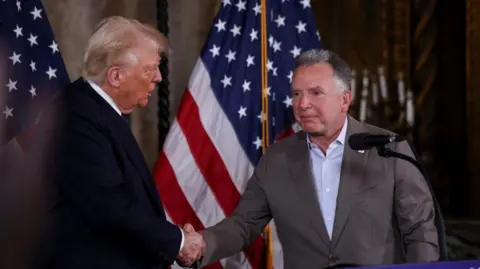 Reuters
ReutersWhen Witkoff returned to Doha, he remained in the room with the talks, spending time with Biden’s envoy Mr McGurk, in what two US officials called a “near unprecedented” transition effort in American diplomacy.
This week, Hamas official Bassem Naim told Al Arabiya he “couldn’t imagine that [the deal] could be possible without the pressure of the incoming administration led by President Trump” – and specifically cited Witkoff’s presence at the talks.
By now, the fact a deal could be imminent was out in the open and public expectation was building – not least among the families of those being held hostage and Palestinians displaced inside Gaza.
The final 72 hours of talks involved a constant back and forth over the finer points of how the deal would be implemented, according to one account.
One source close to the negotiations described the hammering out of “arrangements and logistics” for how the hostages would be released in Gaza and for the withdrawal movements of Israeli troops.
On 12 January, a senior Palestinian official familiar with the negotiations said “all the officials are here in the same building”, adding: “Tonight is decisive. We are only a few steps away from an agreement.”
 Reuters
ReutersThat meeting lasted six hours – but, like so many times before, an impasse was reached.
This time the disagreement that arose was over the mechanism for the return of displaced individuals from southern Gaza to the north.
Israel wanted to search returnees and their vehicles to ensure no militants or military equipment were being transported – which Hamas refused to accept.
Mediators proposed that Qatari and Egyptian technical teams conduct the searches instead. Both sides agreed and one of the final remaining stalemates was resolved.
On 15 January shortly after 18:00, a Hamas negotiator wrote in a message to the BBC: “Everything is finished.”
The podium was being readied.
A deal which once looked impossible had taken shape.
Additional reporting by Sean Seddon






